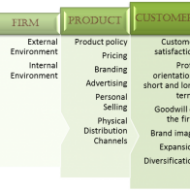Posted by Managementguru in Business Management, Entrepreneurship, Marketing, Principles of Management
on May 15th, 2014 | 0 comments

Market Assessment Framework Industries whether small or large function in an environment of controllable and uncontrollable variables. A small enterprise has to constantly interact with the market in which it has to operate and is also exposed to the risk of other environmental factors. Its marketing efforts must stay fine-tuned to suit the requirements of the market in general and the needs and wants of the customers in particular. They have to develop an exceptional market orientation in light of Intensified industrial activity Increased competition and Increased discerning capacity of customers. Need for Market Assessment: The marketing orientation outlook will drive an entrepreneur to seek answers to many questions relating to market segments, marketing inputs, product quality, price structure, technology of manufacture etc., before setting up the venture. This exercise will facilitate him/her to move ahead with greater degree of confidence and tackle the problems that may arise during the later stages, in a professional manner. Market Composition: Analysis of market demand, the competitive situation and trade practices are vital for a sound market assessment. The market is composed of a large variety of customers who differ in their likes and dislikes, options, preferences, education, employment, income and status. The location of customers also differ, some may be located nearer and others in distant places. Here are 30 Great Marketing Ideas to Increase Sales for Your Small Business: Factors that help a firm to decide the target segment which is of special interest: Resource availability Scale of operation and its Impact on profitability The identification of the customer groups aids in making an estimate of the market demand for the product chosen. Look for Competitive Situation: Once the market demand has been estimated, one has to look for the competitive situation prevailing in the market as a firm cannot just pursue its own policies without considering what the competitors are up to. The nature and extent of competition will place several constraints on the marketing policies of a firm and a thorough analysis of the same will help in pricing and also in identifying the gaps and opportunities that will be available for exploitation. Opportunity Evaluation: An intelligent and experienced entrepreneur would weigh an opportunity as follows: How large is the gap between demand and supply in the market and what is the nature of competition in the market for the product? Whether the product is covered under any of the promotional policies of the government, so that, either entry into business or competition in the market is facilitated. Whether there is any special product/service specific problem that he/she will face and can avail of any part of promotional policies, to soften the impact of these problems. Based on such product-market-policy, policy-product-market type of analysis, the entrepreneur will finally conclude if the opportunity is worth investing...

Posted by Managementguru in Business Management, Marketing, Principles of Management, Strategy
on Mar 4th, 2014 | 0 comments

Product Modification – Solid Strategy to Capture Untouched Market Segments There is a pressing need for business firms to bring about changes in the physical attributes of their existing products periodically, to retain the customer base as well as to tide over the competition in the market. A number of factors may prompt the manufacturer to modify his product. To make best use of the technological advancement for the benefit of the firm Modification in lieu of competition To regenerate a product suffering from sales decline Product Attributes: What could be modified; it may be anything, the color, size, material, functional features, styling and engineering, etc., or a combination of these could be considered for modification. Ultimately these modifications should result in products emerging with better quality, features and styling. Consumer goods are offered with a wide range and variety to appease the different taste of the consumers as well as to stand unique in the market; Bathing soaps, talcum powders and cosmetics to name a few. Even producers, who are involved in core industries like textiles and garments, come out with a range of products to cater to the specific requirements of the customers. Product modification is different from product specialization that applies to high end customers whose specifications are based on the end use of the product and the target market. For example, mélange yarn is a specialized product used for producing better color shades for knitted fabrics (hosiery sector). Product modification concentrates more on increasing the appeal of the product by presenting it with attractive and improved attributes like, better packing and features. Strategy to Improve Quality: The strategy of quality improvement aims at increasing the functional performance of the product- its durability, reliability, speed, taste, etc. The added advantages would be versatility, safety and convenience. The benefits of feature improvement includes, Builds company’s image Can aid in winning over the target market Gives free publicity for the firm Infuses enthusiasm in the internal environment of a firm, amongst the sales force and distributors Style Improvement: Style improvement aims at improving the aesthetic appeal of the product. Why do you think automobile manufacturers are in the process of introducing new models of cars every so often? It is a strategy that amounts to style competition rather than quality or feature competition. This kind of style modification has to be done after extensive market research to gauge the preference of the people in the target market and to avoid colossal monetary loss if in case there is a negative feedback from the market. Manufacturers of house hold products can always take the risk of going for small modifications in terms of texture and style as new features can be adapted quickly, dropped quickly and often made optional at the least expense. A firm has to mix and match its product modification strategies to maintain its competitive position and to keep itself abreast of the latest developments in the market...

Posted by Managementguru in Business Management, Strategy
on Feb 18th, 2014 | 0 comments

What is Distinctive Competence Distinctive Competence is a competency unique to a business organization, a competency superior in some aspect than the competencies of other organizations, which facilitates the production of a unique value proposition in the function of the business. Apple’s distinctive competencies: Innovative culture, successful entry into new markets, human centered design and development. What is distinctive competence? How does it serve as a critical factor for a firm to outsmart its rivals? This is the topic for discussion. Distinctive competence is nothing but the unique capacity of a firm in terms of resources, behavior, strengths and synergy, in relatively or exceptionally large measures. It is the advantage a company has over its competitors, because it can do something that they cannot or it can do something better than they can. Distinctive competence can be in the form of Patents Exclusive access to natural resources Government licenses Pioneer efforts Superior product Product quality Competitive price Unmatched promotional offers, such as discounts and prize coupons Particular attribute of a product-say, highly fuel efficient four wheeler Market niche creation for highly specialized products Superior R and D skills Possessing large number of equity share holders Marketing skills Managerial skills Synergistic work force Supportive union and what not. It is unfortunate that some firms fail to cash in on these competencies for better strategic formulations that might help them to have an edge over their competitors. These critical success factors have to be developed by organizations to capitalize the strategic opportunities that they present for developmental...






